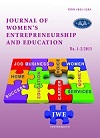Social Organization of Textile – Trading Among Yoruba Women Textile Traders: Implication towards Entrepreneurial Development in Informal Economy in Nigeria
Main Article Content
Abstract
It is unknown how Yoruba women textile traders organize their textile enterprises, despite the vagaries of informal economy. However, in an informal economy, trade in every commodity has its own social organizational structures and politics. Scholars have argued that commodity needs to be separately studied so to detangle the various structures and politics associated with each commodity so that behavioural patterns that lead to entrepreneurial development can be determined. The focus of this paper therefore is to examine the organizational strategies of Yoruba women textile traders. The paper hinges on social action theory by Max Weber. The research design is qualitative in nature. Eight focus group discussions were conducted among the women respondents; Forty (40) in depth- Interview, and six case- studies were conducted. The findings reveals that in social organization of textile trading, several unique methods were adopted such as; placing of exclusive rights on some textile materials, innovation and imitation of textile materials for continuous trading of textile materials. In promotion of textile materials, the finding reveals that economic and non-economic activities were utilized to promote sales. While some classical tenets of entrepreneurship, were adopted by the women in recording the transactions. The paper recommends innovative attitude, importance of role mentors, building of social Capital among other traders in the market, and teaching of record keeping of transaction. All these are essential tools for women entrepreneurship development in informal economy.
Article Details
Section
Once the manuscript is accepted for publication, authors shall transfer the copyright to the publisher. If the submitted manuscript is not accepted for printing by the journal, the authors shall retain all their rights. The following rights on the manuscript are transferred to the publisher, including any supplementary materials and any parts, extracts or elements of the manuscript:
- the right to reproduce and distribute the manuscript in printed form, including print-on-demand;
- the right to print prepublications, reprints and special editions of the manuscript;
- the right to translate the manuscript into other languages;
- the right to reproduce the manuscript using photomechanical or similar means including, but not limited to photocopy, and the right to distribute these copies;
- the right to reproduce and distribute the manuscript electronically or optically using and all data carriers or storage media, and especially in machine readable/digitalized form on data carriers such as hard drive, CD-ROM, DVD, Blu-ray Disc (BD), Mini Disc, data tapes, and the right to reproduce and distribute the article via these data carriers;
- the right to store the manuscript in databases, including online databases, as well as the right to transmit the manuscript in all technical systems and modes;
- the right to make the manuscript available to the public or to closed user groups on individual demand, for use on monitors or other readers (including e-books), and in printable form for the user, either via the Internet, online service, or via internal or external networks.
Authors reserve the copyright to published articles and have the right to use the article in the same manner like third parties in accordance with the licence Attribution-Non-Commercial-Non-Derivate 4.0 International (CC BY NC ND). Thereby they must quote the basic bibliographic data of the source article published in the journal (authors, article title, journal title, volume, pagination).
